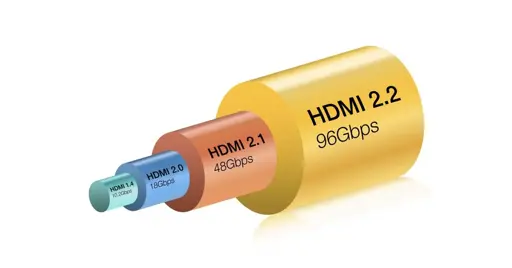The HDMI Forum is using CES — the annual showcase of all things home theater — to announce the new HDMI 2.2 specification. In a press release this morning, the trade association confirmed that the new spec will up total bandwidth significantly to a new high of 96Gbps. And yes, that means the introduction of an “Ultra96” HDMI cable that “enables all the HDMI 2.2 specification features.”
“Higher resolutions and refresh rates will be supported and more high-quality options will be provided,” the HDMI Forum said in its release. An example of an HDMI 2.2 cable (below) calls out some of those, including 4K at up to 480Hz, 8K at up to 240Hz, and 10K at 120Hz. Current HDMI cables can already pass 4K at 120Hz, so I doubt most people will feel any temptation to upgrade for years to come. And you’ll need content for any of these higher resolutions to be worthwhile, and there’s still a dearth of native 8K entertainment out there.
But with many TVs now offering 4K at up to 144Hz, and as consumers gravitate towards larger screens, the HDMI Forum sees ample reason to keep pushing forward.
There is at least a more helpful aspect of this spec for everyone: HDMI 2.2 includes a “Latency Indication Protocol (LIP) for improving audio and video synchronization, especially for multiple-hop system configurations such as those with an audio video receiver or soundbar.” In my experience, HDMI 2.1 and eARC have mostly resolved frustrating audio / video sync issues, but they can still pop up as a frustration depending on your setup. Apparently HDMI 2.2 will go further in keeping everything lined up and keeping this headache in the past.
Interestingly, the HDMI Forum is already anticipating tariff issues and has implemented an extensive certification program that includes anti-counterfeit labeling on packaging. You certainly can’t miss the Ultra96 badging.
HDMI 2.2 will be released in the first half of this year and be widely available “to all HDMI 2.x adopters.” Your TV and external devices will need to support the specification in order to unlock that new level of bandwidth, so we’re just starting down what’s inevitably going to be a long road.
Can anyone ELI5 how we are able to release new standards all the time? Are there technological advances that allow more bandwidth? If not, why not start with higher bandwidth?
Going for higher bandwidth tends to increase signal interference. There are various ways to deal with that, most of which cost money. For example, most high speed data cables use twisted pairs that help cancel out interference. To go faster, the twists need to be tighter, and that’s more expensive to make.
If there is no customer demand for those use cases, then there’s no reason to force a more expensive cable, connector, or signalling electronics just so you can meet specs.
Makes sense, thanks!




